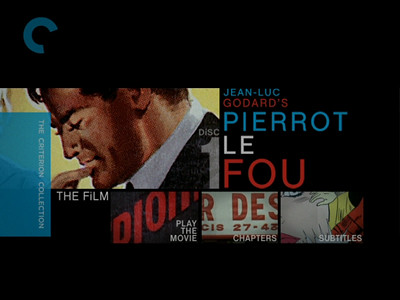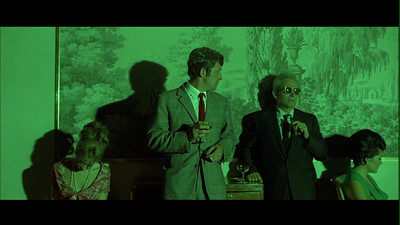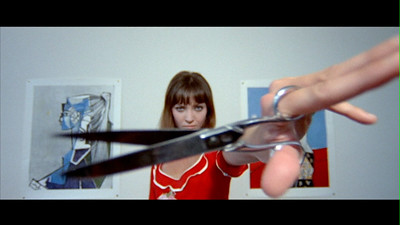
If ever there was a Godard movie that deserved to be iconic, it's Pierrot le fou, which itself is one long chain of icons and iconic images bound end to end. Icons from dime novels, Hollywood cinema, great works of art, pop culture, poetry, and children's stories, simultaneously looking backward and forward while being very much of its time.
"Pierrot le fou" (fou: clown, fool, madman) is the nickname given to Ferdinand (Jean-Paul Belmondo) by his girlfriend Marianne (Anna Karina). At the start of the film, Ferdinand is a family man eager to escape his life of quiet desperation, seeking refuge in stories about artists and American movies; at the end of the movie, he has painted his face blue and wrapped himself in dynamite, a living art project. In the final moments, he regrets everything and tries to take it back. It's too late.
Not that he couldn't have seen it coming. Marianne has dubbed him the cuckold, the name Pierrot referring to a clown in the Commedia dell'Arte who wanders the stage wearing a frown, distraught over his dashed love for Columbine, who has jilted him in favor of the colorful Harlequin. Pierrot wears white robes, the blank slate of a drab existence. This is what Marianne sees when she sees Ferdinand, no matter how much he denies the christening.

Marianne isn't all bad. The couple is in love, even if the love goes up like the bathtub of napalm the pair discusses in the film. I think there is evidence in all of Jean-Luc Godard's movies that he believed in true love. It's just that he also believed that truth turns to lies eventually, and this is the essential rollover that comes in Pierrot le fou. Ferdinand and Marianne lie to each other and they lie to themselves.
The two actually dated five years prior to their reconnecting at the start of the film. Ferdinand and his wife (Graziela Galvani) are going out for the evening with another couple, and the other husband (Georges Staquet) has offered to bring his niece to babysit their kids. Ferdinand immediately insists that, knowing his friend, the babysitter won't be his real niece but a call girl pretending to be. What does it mean, then, when she is really Ferdinand's old flame come back from wherever that flame was extinguished?
With Marianne back in his life, Ferdinand immediately leaves his family and goes on the road with her. They begin a life of crime, a killing spree to envy that of Bonnie and Clyde. Pierrot le fou predates Arthur Penn's bloody tribute to that infamous couple by two years (Bonnie & Clyde

Pierrot le fou doesn't stop short at being just a crime picture, though, it's also one of Godard's most incisive examinations of how men and women communicate. When Marianne is brought over to babysit, Ferdinand and the others go to a party where everyone speaks in advertising copy. There, Ferdinand meets the real-life film director Samuel Fuller, a hard-as-nails movie maker and a big influence on Godard. Through his character, Godard asks Fuller to define cinema, and the mentor says that cinema is emotions. Unbeknownst to Ferdinand, he's already proving that, the lighting on the screen changing colors like a mood ring, reflecting Ferdinand's nausea and malaise through queasy tints carefully chosen by genius cinematographer Raoul Coutard.
The road trip that follows is good for the duo as long as it's one powered by emotion, but as soon as they slow down and have time to rationalize, it all starts to go pear-shaped. Though they begin on the same page, speaking in poetic declarations and fractured dialectics, Ferdinand and Marianne eventually lose the ability to communicate. He is obsessed with books, but she wants to listen to music. According to Marianne, he speaks in words, but she looks in feelings. Even in their false drama, a play about the Vietnam War they perform for Americans at the seaside, they are at odds: he is the bullying nephew of Uncle Sam, she the seemingly helpless niece of Uncle Ho, lying in wait to jump out with a grenade the moment he underestimates her.
So it will be with their real life of crime, too, with their real life of amour. He is just playing, but she's living it. He is engaging in an intellectual exercise, but she is in it whole-heartedly, and before Ferdinand knows it, it's gone too far and she's gone again.
Though Godard lets the lovers linger in their quieter moments, he moves the transitions at a rapid pace, quick cutting through classical paintings, pulp magazine covers, and comic book imagery. His romantics speak underneath the images, naming their activities after famous books. Pierrot le fou is a pop art explosion, the convergence of centuries of entertainment coming together in a way that equalizes them all without lacing it with the irony of the Warhol school. This is also how Godard can stitch together all of the films he loves, how Marianne can be named for Renoir (the painter and his son, the director), how they can commit a robbery using tricks learned from Laurel and Hardy. As I've suggested, even when Godard doesn't mean to, he evokes other cinematic works. As Marianne's story gets more confused, I am sure I am not the only one who has wondered if her brother and Fred (Dirk Sanders) are the same person, which brings to mind the other absent brother named Fred who belonged to Holly Golightly, the equally alluring girl who spouted so many fictions in Breakfast at Tiffany's

On the subject of reinvention, something must be said for the knock-out job Criterion has done here on their new two-disc release of Pierrot le fou. Fans of the movie have had to make due with the 1998 Fox Lorber release of the movie. Calling that DVD woefully inadequate would be kind. The new transfer, overseen by Coutard, is galaxies away from the faded and uninspired old version. The colors are bright and pop from the screen, every detail coming alive and clearly visible. You'll feel like you're seeing Pierrot le fou for the very first time. (You can view comparison shots from the old DVD by following these links: an image from the same party scene with Fuller here and of the night driving scene here. They show how bad the old disc was. The color correction was way off.)
Special praise must also be given to the art direction on the disc. As with many of their other Godard discs (Masculin Feminin and A Woman is a Woman immediately spring to mind), the art team has taken their cue from the movie itself, designing the packaging to go hand-in-hand with the treasure it holds. From the front cover through the booklet, to the images on the discs and the menus on the screen, the fonts share the same quirks as Godard's credits, and the images aren't just chosen from the collages of imagery the director put together, but they've isolated stills and captures from the movie that share the same totemic quality.
The second disc of supplemental features won't disappoint, either. Old interviews with the actors and director sit alongside a new chat with Anna Karina; there is a lengthy documentary about the off-screen relationship between Godard and Karina, and there is also a guide to the allusions laced through the film, once more following in the tradition of other Godard Criterions like Breathless and Band of Outsiders.
And, of course, there is the theatrical trailer, which Godard fans know are usually like mini films unto themselves.

No comments:
Post a Comment